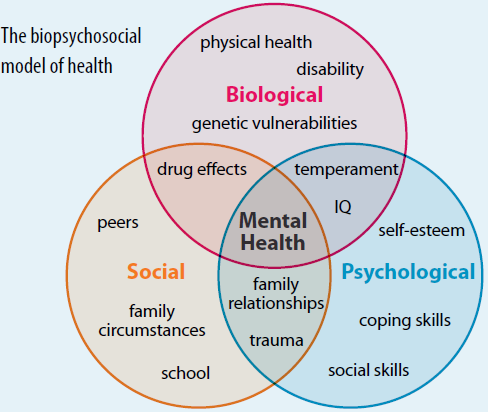Determinants of Health: Difference between revisions
Rachael Lowe (talk | contribs) No edit summary |
Rachael Lowe (talk | contribs) No edit summary |
||
| Line 69: | Line 69: | ||
== Resources == | == Resources == | ||
*[http://www.who.int/social_determinants/advocacy/health-post-2015_sdh/en/ Health in the post-2015 development agenda: need for a social determinants of health approach: joint statement of the UN Platform on Social Determinants of Health]. | *[http://www.who.int/social_determinants/advocacy/health-post-2015_sdh/en/ Health in the post-2015 development agenda: need for a social determinants of health approach: joint statement of the UN Platform on Social Determinants of Health]. | ||
*[https://www.ncbi.nlm.nih.gov/pmc/articles/PMC3863696/ The Social Determinants of Health: It's Time to Consider the Causes of the Causes] | |||
== References == | == References == | ||
<references /> | <references /> | ||
Revision as of 16:31, 6 January 2017
Original Editor - Rachael Lowe
Top Contributors - Rachael Lowe, Wendy Walker, Naomi O'Reilly, Kim Jackson, Jess Bell, Laura Ritchie, Rucha Gadgil, Robin Tacchetti, Tarina van der Stockt, Vidya Acharya, Shaimaa Eldib and Carin Hunter
Introduction[edit | edit source]
"Health care is an important determinant of health. Lifestyles are important determinants of health. But... it is factors in the social environment that determine access to health services and influence lifestyle choices in the first place." WHO Director-General Dr Margaret Chan[1]
Many factors combine together to affect the health of individuals and communities. Whether people are healthy or not, is determined by their circumstances and environment. To a large extent, factors such as where we live, the state of our environment, genetics, our income and education level, and our relationships with friends and family all have considerable impacts on health, whereas the more commonly considered factors such as access and use of health care services often have less of an impact.
Determinants of health[edit | edit source]
The range of personal, social, economic, and environmental factors that influence health status are known as determinants of health.
These can be classified as:
- the social and economic environment,
- the physical environment, and
- the person’s individual characteristics and behaviours.
There are many comonly accepted determinants of health but there is no single definition. The Office of Disease Prevention and Health Promotion (ODPHP) has broadly categorised the determinants of health[2], these have been summarised below:
Policymaking[edit | edit source]
Policies at the local, state, and federal level affect individual and population health. Increasing taxes on tobacco sales, for example, can improve population health by reducing the number of people using tobacco products.
Social Factors[edit | edit source]
Social and physical determinants of health reflect the conditions of the environment in which people are born, live, learn, play, work, and age. Also known as social determinants of health, they impact a wide range of health, functioning, and quality-of-life outcomes.
Examples include:
- Availability of resources to meet daily needs, such as educational and job opportunities, living wages, or healthful foods
- Social norms and attitudes, such as discrimination
- Exposure to crime, violence, and social disorder
- Social support and social interactions
- Socioeconomic conditions, such as concentrated poverty
- Quality schools
- Transportation options
- Urbanisation and the built environment, such as buildings or transportation
- Worksites, schools, and recreational settings
Health Services[edit | edit source]
Both access to health services and the quality of health services can impact health. Barriers to accessing health services include lack of availability. high cost, lack of insurance coverage, limited language access. These barriers to accessing health services lead to unmet health needs, delays in receiving appropriate care, inability to get preventive services, hospitalizations that could have been prevented.
Individual behaviour[edit | edit source]
Individual behaviors such as diet, physical activity, alcohol, tabacco, and other drug use also play a role in health outcomes.
Biology and genetics[edit | edit source]
Some biological and genetic factors affect specific populations more than others. Examples of biological and genetic determinants of health include age, sex, inherited conditions, genetic make up.
Relevance to Physiotherapy[edit | edit source]
In our contact time with our patients we spend a lot of time understanding thier health and social status, in other words we explore and determinants that might be affecting their health, and in particular ones that we can influence. The model we use to analyse and understand these determinants of health is the biopsychosocial model of health care.
Resources[edit | edit source]
- Health in the post-2015 development agenda: need for a social determinants of health approach: joint statement of the UN Platform on Social Determinants of Health.
- The Social Determinants of Health: It's Time to Consider the Causes of the Causes
References[edit | edit source]
- ↑ Dr Margaret Chan. Launch of the final report of the Commission on Social Determinants of Health. 2008. Accessed online 6 January 2017.
- ↑ Office of disease prevention and health promotion. Determinants of Health. Accessed online 6 January 2017.







